1. What Is A Butcher Knife?
Ever wonder what that big kitchen knife with a curved blade is called — and if it’s really worth buying? It’s called a butcher’s knife; you certainly don’t have to be a professional butcher to find out what it can do. After all, even home cooks need to cut raw and cooked meat and this tool makes the job go so much smoother.
While a chef’s knife can be a good option, a butcher’s knife is designed for butchering and breaking down large pieces of meat with a long, curved blade. The blade length allows you to achieve long, smooth slices out of even the toughest hunk of beef or delicate fish, while the curve helps you maneuver under skin and around bones to quarter a chicken without a hitch. Butcher’s knife blades tend to be super-sharp and thick, making them durable enough to really get between the meat and the bone to break them apart.
2. How To Use A Butcher Knife?
(1)For skinning
Use the very tip of the blade for getting between the skin and meat, and then the curved part is helpful for separating it more.
(2)For slicing, cutting or chopping
Direct the full length of the blade horizontally to make long, clean slices or to trim the meat. To chop or cut, position the blade vertically to the meat.
(3)For deboning
Guide the curved part of the blade around the bone. When touching the bone, the blade can be rotated to push the bone away and separate it from the meat.
3. Difference Between A Butcher Knife And A Cleaver
The most apparent difference between a butcher knife and a cleaver is the size and shape of the blade. The butcher knife has a long, slim blade and often has an upward curve toward the point. The cleaver is a short and broad blade with a thick spine.
Butcher knives and cleavers can break down meat, but a butcher knife can also trim fat and skin, make precise cuts, or even portion a large pizza.
Butcher knives are sharper and lighter and offer more cutting options than a cleaver, such as slicing, chopping, hacking, sawing, and trimming. Cleavers are best for hacking, chopping, smashing, and splitting motions.
A butcher knife is best if you need to slice or chop meat or vegetables. A cleaver is better if you must hack through a tough cut of meat.
In conclusion, there is yet to be a clear winner regarding the butcher knife vs. cleaver debate. It depends on your preferences and what you will use the knife for. If you are looking for a general-purpose knife that can be used for various tasks, then the butcher knife is a good choice. If you are looking for a blade specifically designed for chopping, then the cleaver is the better option.
4. How To Pick The Best Butcher Knife
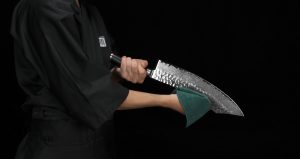
(1)Balance
When we talk about balance, we are referring to the feel of the blade in your hand. The knife should feel balanced in your hand – there should be equal weight distribution, and it shouldn’t feel as though one piece of the knife is much heavier than the other. A well-balanced knife provides you with more control, allowing you to fully carry out all your butchering tasks with less fatigue on the wrist and hand.
(2)Size
Butcher’s knives can range in length from six inches to 14 inches. Eight to 10-inch butcher’s knives are popular for home cooks, while professional chefs often opt for larger ones. Obviously, smaller sizes are good for getting around bone or trimming excess fat or sinew from the muscle. The larger sizes are good for quickly and in a single swipe portioning off pieces from larger cuts of meat.
(3)Blade
The sharpness of the blade, and its edge retention, are both extremely important topics when researching blades to buy. Butcher knives tend to be thicker than others, because they’re meant to get through tough pieces of meat without the fear of breaking or chipping them. Therefore, to get the highest quality product, be sure to choose high-carbon stainless steel, which is known for maintaining sharpness for a long time.
(4)Handle
The handle of a good butcher knife should be made of wood or textured rubber. A slick handle will allow the knife to slip from or roll within your hand, causing the blade to turn and possibly cut you. Wooden handles are often preferred.
5. The Best Butcher Knives To Buy
If you’re looking for a piece that not only slices through anything that comes in its path but also has the look and feel of a work of art, the Butcher Knife from YOUSUNLONG is a great option. These samurai sword-like butcher knives are the sharpest available. Available in 8, 10 and 12 inch lengths, the knife will come in handy for a variety of kitchen tasks.
PROS:
- The blades feature incredibly sharp, imported Japanese 67-ply high carbon content steel core Damascus steel, HRC 60±.
- You’ll get clean, straight cuts with these blades, with a hand sharpened edge to 15° per side, expertly heat treated and honed to perfection.
- Butcher’s Knives surface convex hull with anti-stick effect.
- Premium natural walnut, ebony, and olive wood handles.
- Smart design and engineering make this a knife to proudly flaunt, a great gift for home cooks.
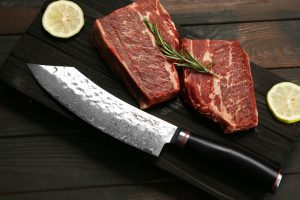
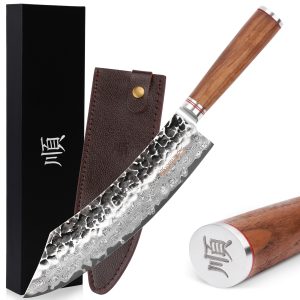
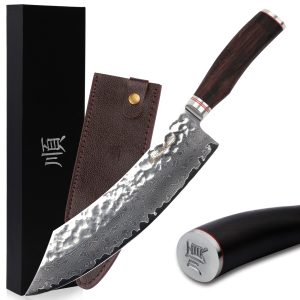
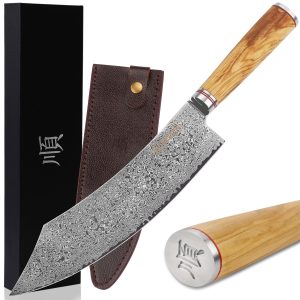
Thank you a lot for giving everyone such a terrific opportunity to read from this website. It is often so useful and also packed with amusement for me personally and my office co-workers to search your web site nearly three times in 7 days to see the latest stuff you have. And of course, I’m just usually motivated for the tremendous creative ideas you serve. Some two points on this page are basically the very best we have had.
thanks to the author for taking his time on this one.